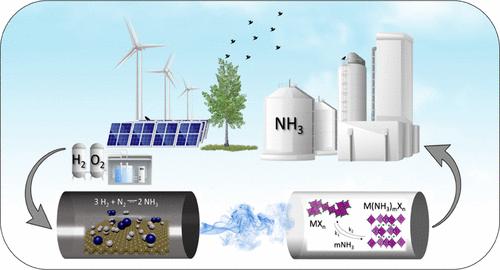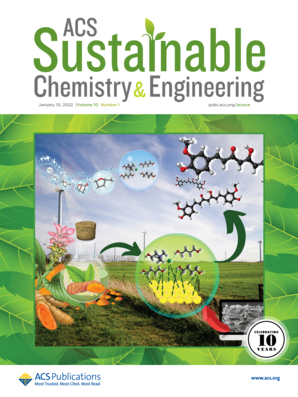Catalytic Reactor-Utilized Ammonia Adsorption, Absorption, and Storage Materials: Mechanism, Nanostructure, and Ab Initio Design
IF 7.1
1区 化学
Q1 CHEMISTRY, MULTIDISCIPLINARY
引用次数: 0
Abstract
As the world’s technological development shifts toward a sustainable energy future by harnessing renewable energy sources, ammonia is gaining recognition as a complementary green vector to hydrogen. This energy-dense carbon-neutral fuel is capable of overcoming hydrogen’s limitations in terms of storage, distribution, and infrastructure deployment. The biggest challenge to the global use of ammonia as an energy storage medium remains more efficient, readily deployable production of ammonia from abundant, yet intermittent, sources. Green decentralized ammonia production, which refers to the small-scale, localized ammonia production utilizing environmentally sustainable methods, offers a promising approach to overcoming the challenges of traditional ammonia synthesis. The process aims to minimize carbon emissions, increase energy efficiency, and improve accessibility to ammonia in remote regions. Ammonia separation using sorbent materials holds significant potential in green ammonia production, providing a viable alternative to conventional condensation-based separation methods, with particular benefits in improving energy efficiency. This perspective summarizes recent developments in the field of ammonia separation, focusing on newly developed sorbents for the integrated ammonia synthesis–separation process, particularly metal halides that could potentially replace a conventional ammonia condenser. The challenges and potential solutions are also discussed. Moreover, this perspective outlines the mechanism of ammonia absorption into metal halides with its kinetics and thermodynamics. The use of computational methods for the development of new materials is also described, thereby laying the foundations of green ammonia technology.

催化反应器利用的氨吸附、吸收和储存材料:机理、纳米结构和 Ab Initio 设计
随着世界技术发展转向通过利用可再生能源实现可持续能源的未来,氨作为氢的补充性绿色载体正日益得到认可。这种高能量的碳中性燃料能够克服氢气在储存、分配和基础设施部署方面的局限性。在全球范围内使用氨作为储能介质所面临的最大挑战仍然是如何更高效、更方便地利用丰富但间歇性的资源生产氨。绿色分散式氨生产是指利用环境可持续方法进行小规模、本地化的氨生产,它为克服传统氨合成的挑战提供了一种前景广阔的方法。该工艺旨在最大限度地减少碳排放,提高能源效率,并改善偏远地区氨的可获得性。使用吸附剂材料进行氨分离在绿色合成氨生产中具有巨大潜力,可替代传统的基于冷凝的分离方法,在提高能源效率方面具有特殊优势。本视角总结了氨分离领域的最新发展,重点关注用于氨合成-分离一体化工艺的新开发吸附剂,特别是有可能取代传统氨冷凝器的金属卤化物。此外,还讨论了所面临的挑战和潜在的解决方案。此外,本视角还概述了金属卤化物吸收氨的机理及其动力学和热力学。还介绍了如何利用计算方法开发新材料,从而为绿色氨技术奠定基础。
本文章由计算机程序翻译,如有差异,请以英文原文为准。
求助全文
约1分钟内获得全文
求助全文
来源期刊

ACS Sustainable Chemistry & Engineering
CHEMISTRY, MULTIDISCIPLINARY-ENGINEERING, CHEMICAL
CiteScore
13.80
自引率
4.80%
发文量
1470
审稿时长
1.7 months
期刊介绍:
ACS Sustainable Chemistry & Engineering is a prestigious weekly peer-reviewed scientific journal published by the American Chemical Society. Dedicated to advancing the principles of green chemistry and green engineering, it covers a wide array of research topics including green chemistry, green engineering, biomass, alternative energy, and life cycle assessment.
The journal welcomes submissions in various formats, including Letters, Articles, Features, and Perspectives (Reviews), that address the challenges of sustainability in the chemical enterprise and contribute to the advancement of sustainable practices. Join us in shaping the future of sustainable chemistry and engineering.
 求助内容:
求助内容: 应助结果提醒方式:
应助结果提醒方式:


